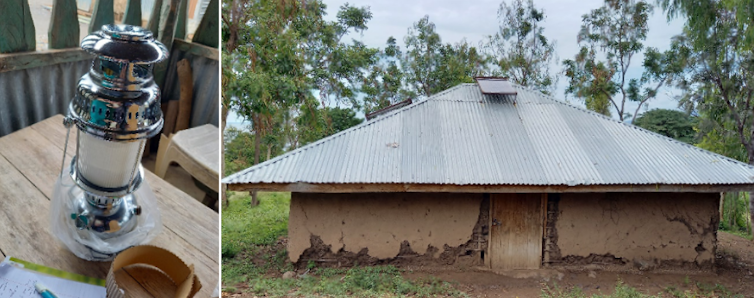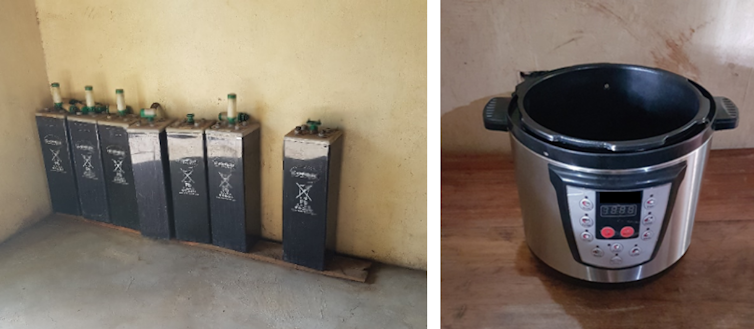To allow the 43% of inhabitants of sub-Saharan Africa living without electricity to have access to it, it will already be necessary to assess the electricity needs of populations who have never had it.
600 million people do not have access to electricity in Sub-Saharan Africa, or 43% of the population. The United Nations has placed this issue at the heart of one of its sustainable development goals: ensuring universal access to clean, sustainable and affordable energy by 2030. To achieve this objective, the United Nations Development Program (UNDP) promotes the development of isolated mini-grids to electrify communities often far from national electricity networks. This would be, develops the International Energy Agency, the least expensive option for more than a third of future connections in Sub-Saharan Africa from here to 2030.
These isolated mini-networks are electrical systems made up of one or more means of production (photovoltaic panels, generator using diesel) with or without storage (batteries) and a distribution network which operates independently of the national network. They thus make it possible to provide access to electricity, without resorting to the often slow and costly extension of national networks.
If the majority of mini-grids installed in recent decades relied on generators, more and more mini-grids today integrate photovoltaic panels and batteries To reduce their diesel consumption and minimize their costs, we are talking about solar/diesel hybrid mini-grids. Thus, these mini-grids relying increasingly on solar energy seem a promising solution for accelerating rural electrification while reconciling low energy costs and low greenhouse gas emissions. But from theory to practice, what really happens?

Examples of isolated mini-grids in Kenya: on the left, the generators of the Mfangano mini-grid, on the right the solar installation of the Talek mini-grid.
Emilie Etienne, Provided by the author
The benefits of solar energy for mini-grids
The choice between different electrification solutions is generally dictated by economic contingencies. The production costs of solar photovoltaic have been divided by 5 in 10 years, thus falling below the average production costs of generators in many countries, with a few exceptions, such as Nigeria where fossil fuels are subsidized. Replacing part of the production of a generator with solar energy thus makes it possible to reduce electricity costs, hence the current boom in solar/diesel hybrid mini-networks.
In addition to reducing the costs of mini-grids, integrating solar energy also makes it possible to reduce the dependence of populations on a fossil resource whose price varies greatly and whose supply is not always guaranteed in remote areas where these systems are installed, with, for example, great uncertainties about the arrival of diesel when heavy rains make certain roads unusable.
This reduction in diesel consumption is also accompanied by a reduction in greenhouse gas emissions. Although the countries of Sub-Saharan Africa have emissions levels much lower than those of industrialized countries, they are also committed to the development of renewable energies and to carbon neutrality trajectories.
100% solar mini-grids: an emissions-free solution?
But when we are interested in the greenhouse gas emissions of an energy system, it is important to take into account the emissions over the entire life cycle of this system, i.e. its carbon footprint. Indeed, if the emissions linked to a generator occur mainly during its use, the emissions associated with photovoltaic panels or batteries on the contrary, come from their manufacture (raw material extraction, material processing, assembly). In the case of 100% solar mini-grids, these indirect emissions are far from negligible : they represent around a quarter of the carbon footprint of a mini-grid operating exclusively with generators.
These relatively high emissions despite the absence of fossil resources come from the need for these mini-grids to manage the co-variability between the intermittent local solar resource and electricity demand. To provide electricity at night or in cloudy weather, without access to a controllable, low-carbon energy source (hydroelectricity for example), it is necessary to store solar energy in batteries.
It is also possible to install more photovoltaic panels to produce more energy and reduce the need for storage, particularly for long periods of low solar resources. The indirect emissions linked to this storage and these additional panels increase the carbon footprint of 100% solar mini-grids which is then equivalent, or even higher, for many African countries, to the carbon footprint of their electricity mix on the national network.
This need for storage or additional panels is all the greater as electricity demand is high during these periods of low solar resources. Hence the importance for mini-grid developers to have a good understanding of the variability of the local solar resource, but also of the electrical demand to correctly size the system, i.e. the number of panels and batteries to install. Currently, we can have a fairly good estimate of the solar resource thanks to in situ measurements or to satellite data, but the same is not true for the estimation of electricity demand.
Adaptation to demand: one of the major challenges of mini-grids
This is in fact a major problem: how to estimate the electricity demand of a community that does not have access to electricity? We can first get an idea by observing the characteristics of the community: number of inhabitants, activities already present (fishing, agriculture, artisans, etc.), types of housing, etc. For a more complete vision, we ask residents about their desire to connect, about the electrical equipment they would like to have, about their income, about their current uses of energy – kerosene or solar lamps, individual generator, wood. /coal for cooking, solar home systems (consisting of a panel and a battery that can power lighting, phone chargers, radio, etc.).
 On the left, a kerosene lamp used by the fishermen of Mfangano (Kenya). On the right, solar panels on a roof in Kisii (Kenya).
On the left, a kerosene lamp used by the fishermen of Mfangano (Kenya). On the right, solar panels on a roof in Kisii (Kenya).
Photos: Emilie Etienne, April-May 2022, Provided by the author
But these methods remain very imprecise. Faced with new uses, some residents can overestimate their capacity to obtain certain equipment or to pay for their use. The replacement of some existing energy sources with mini-grid electricity depends on several factors that are not always correctly identified by mini-grid developers. Surveys are most often carried out over a short period and do not take into account variations in income and habits of the population over the year (harvest periods, school expenses, etc.). Furthermore, these studies do not make it possible to estimate how this demand will evolve in the years to come.
In the case of a diesel mini-grid, these difficulties in predicting demand are not critical: the mini-grid operator can adapt relatively easily to poorly estimated demand. The investment costs in generators are low, more than necessary can be installed initially or added later in case demand is greater than expected. And if this is lower than expected, diesel consumption will be lower, reducing production costs for the operator.
On the other hand, it is not the same for solar mini-grids. Photovoltaic panels and batteries have low operating costs but require a very significant initial investment, which is largely based on credits. The repayment of these credits represents fixed costs, independent of electricity consumption and which are often spread over more than ten years.
Thus, if demand has been overestimated, the operator does not draw enough revenue from the mini-network to ensure repayment of credits, maintenance, and replacement of equipment, particularly batteries. This leads to a more or less slow degradation of the mini-grid and reduces the availability and reliability of electricity (frequent outages, limited operating times).
A similar result can be obtained when demand has been underestimated: the time required to find funds and expand the system is often not sufficient to avoid equipment overload and equipment degradation that jeopardizes the reliability of the system. mini-grid. In both cases, users often end up switching away from the mini-grid by returning to their old energy sources (kerosene lamps, etc.) or investing in individual systems.
This demand risk leads investors to demand much higher returns, leading to a sharp increase in capital costs. which impacts the cost of electricity. It also leads certain operators to develop business models based on more or less aggressive marketing strategies: users of the mini-network are regularly contacted by sending SMS or by visits from “ambassadors” (users who benefit from benefits in exchange for the promotion of electricity to the community) to encourage them to increase their consumption or to purchase electric cooking appliances on credit.
Added to this major risk are other obstacles, such as the arrival of the national network, the procedures for obtaining licenses, the choice of tariff and the monopoly of the national network, which reduce the attractiveness of these projects. electrification and slow down their development.
 On the left, used batteries from the Talek mini-grid (Kenya). On the right, an electric cooker sold on credit by a mini-grid operator in Kisii (Kenya).
On the left, used batteries from the Talek mini-grid (Kenya). On the right, an electric cooker sold on credit by a mini-grid operator in Kisii (Kenya).
Photos: Emilie Etienne, April-May 2022, Provided by the author
A situation that can improve
Thus, solar mini-grids are not yet delivering on their promises as a low-cost, low-emissions solution to quickly electrify Sub-Saharan Africa. And that’s without even talking about other environmental impacts. related to batteries or energy justice issues associated with these systems. However, in their hybrid solar/diesel form, they currently constitute an interesting compromise to meet certain vital needs of populations far from national networks while limiting the impact of the use of generators massively widespread on the continent.
Several avenues remain to be explored to increase the potential of these solutions by reducing both their costs and their environmental impacts. An important avenue is that of increasing the lifespan of these mini-networks, which is often shorter than expected. This requires expanding research into questions of maintenance, governance and the methods of financing these projects which can notably affect the capacity of these mini-networks to adapt to changing community needs.
We can also hope that the costs and carbon footprint of the technologies used in these mini-grids will decrease over time. The carbon footprint of a panel or battery is very variable and depends largely on the energy mix with which these components are produced. The decarbonization of energy mixes and potential efficiency gains in the extraction and manufacturing processes of these components could at least halve the carbon footprint of solar mini-grids. Likewise, the massive deployment of these technologies around the world could encourage the emergence of component recycling sectors which today represents an important issue in the development of mini-grids.![]()
Theo Chamarande, Post doctoral, Grenoble Alpes University (UGA)
This article is republished from The Conversation under Creative Commons license. Read the original article.


